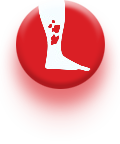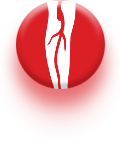Conditions.
Discover comprehensive insights into vascular conditions and diseases in Dubai, United Arab Emirates
Peripheral Arterial Disease
Peripheral Arterial Disease (PAD) Is a condition where the arteries become narrowed or blocked (occluded) by a buildup of plaque of fatty deposits called atherosclerosis. This causes a restriction for blood getting to where it needs to go.

Chronic Ulcers
Chronic ulcers are areas on the legs, ankles or feet where underlying tissue damage or a trauma has caused skin loss, leaving a raw wound that takes a long time to heal.

Varicose Veins
Varicose veins, otherwise known as varicosities, are veins that have become distended and tortuous. When they are close to the skin’s surface, they are raised, dark and knobby in appearance.

Renal Mesenteric Intervention
Renal mesenteric disease is a condition caused due to hardening of renal arteries. Normally, your arteries are smooth and unobstructed on the inside buy a sticky substance called ‘plaque’.

Thoracic Aortic Aneurysm
Thoracic Outlet Syndrome (TOS) is a group of conditions where the nerves, arteries and/or veins in the “thoracic outlet”, or the path from your lower neck to your armpit are compressed.

Mesenteric Aneurysm
An aneurysm is a condition where the walls of a blood vessel weaken. Over a period of time, the pressure of the blood flowing through the vessel causes it to expand or bulge at the point of weakness.

Popliteal Artery Entrapment
A very rare vascular condition characterized by chronic leg ischemia and claudication. It may be caused by abnormal positioning of the popliteal artery and can lead to serious disability.

Lymphedema and Leg Swelling
Lymph vessels and lymph nodes along with the clear lymphatic fluid running through them, make up the body’s lymphatic system. Lymph vessels function by collecting fluid (made of fats, wastes, proteins and water) from the cells of your body and delivering them to the lymph nodes.

Thoracic Outlet Obstruction Syndrome
The thoracic outlet is a small passageway leading from the base of the neck to the armpit and arm. This small area contains many blood vessels, nerves and muscles. When this passageway becomes compressed, the condition is termed as thoracic outlet syndrome.

Carotid Aneurysms and Visceral Aneurysm
A carotid artery aneurysm is a ballooning or bulging of the carotid artery in the neck. A visceral artery aneurysm is a ballooning of a portion of any of the arteries that supply the kidney, liver, spleen, and intestine.

Carotid Artery Disease
Carotid Artery Disease (CAD) is a condition where the carotid arteries become narrowed or blocked (occluded) by a buildup of plaque that is made up of fatty deposits called atherosclerosis.

Deep Vein Thrombosis
Deep Vein Thrombosis (DVT), otherwise known as deep venous thrombosis, is a blood clot in the deep veins of the body. Unlike superficial veins, deep veins cannot be seen from the skin’s surface.

Thoracic Outlet Syndrome
Thoracic Outlet Syndrome (TOS) is a group of conditions where the nerves, arteries and/or veins in the “thoracic outlet”, or the path from your lower neck to your armpit are compressed.

Adbominal Aortic Aneurysm
An aneurysm is a condition where the walls of a blood vessel weaken. Over a period of time, the pressure of the blood flowing through the vessel causes it to expand or bulge at the point of weakness.

Peripheral Artery Aneurysm
An aneurysm is a condition where the walls of a blood vessel weaken. Over a period of time, the pressure of the blood flowing through the vessel causes it to expand or bulge at the point of weakness.

Popliteal Vein Compression
The popliteal vein is a blood vessel that carries blood from the foot and calf to the heart. Popliteal vein compression refers to the constriction of these veins behind the knee, between the muscle layers that surround them.

Chronic Venous Insufficiency
Chronic venous insufficiency (CVI) is a condition where veins have difficulty sending blood from your limbs back to your heart. When blood collects in the leg veins and pools due to impaired circulation it is called stasis. CVI is associated with varicose veins and often causes swelling and pain in the legs. CVI affects almost 20 percent of men and 40 percent of women over the age of 50 years.

Diabetic foot and its complications
Diabetes is a chronic condition that is characterized by high blood glucose (sugar) levels. Diabetic patients are at a high risk for developing chronic wounds, especially in the feet. If left untreated, these wounds can cause serious problems that can lead to infections and eventually gangrene, which may require amputation.

Chronic Non-healing Leg Ulcers
Ulcers on the leg that do not demonstrate any tendency to heal even after a long time. They may be caused due to peripheral vascular disease.

AV Malformations
Oxygenated blood in the arteries and deoxygenated blood in veins normally flow separately through the body. At the tissues, they each break up into a network of tiny capillaries where blood flow slows down allowing the exchange of gases to and from the tissues.
I'm writing to express deep gratitude for Dr. Ibrahim Riza. His professionalism, extensive knowledge, and compassionate care were evident from my first clinic visit. He not only addressed my medical concerns thoroughly but also provided genuine empathy, making me feel confident and well-informed throughout my treatment decisions. . . Read full testimonial
— G. Rooney
I'm deeply grateful for your exceptional care during my life-threatening emergency with a ruptured aortic aneurysm. Your swift action and skilled procedure saved my life. Your thorough explanations, empathetic approach, and reassuring manner brought me confidence and hope in a moment of panic. Your blend of technical proficiency and. . . Read full testimonial
— B. Prince
I'm writing this testimonial to express heartfelt gratitude for the exceptional care I received at your clinic. Dr. Riza, your professionalism and compassion were evident throughout, from your expertise in explaining varicose vein treatment options to your team's proactive and caring approach in arranging appointments and addressing concerns. . . Read full testimonial
— M. Kaur